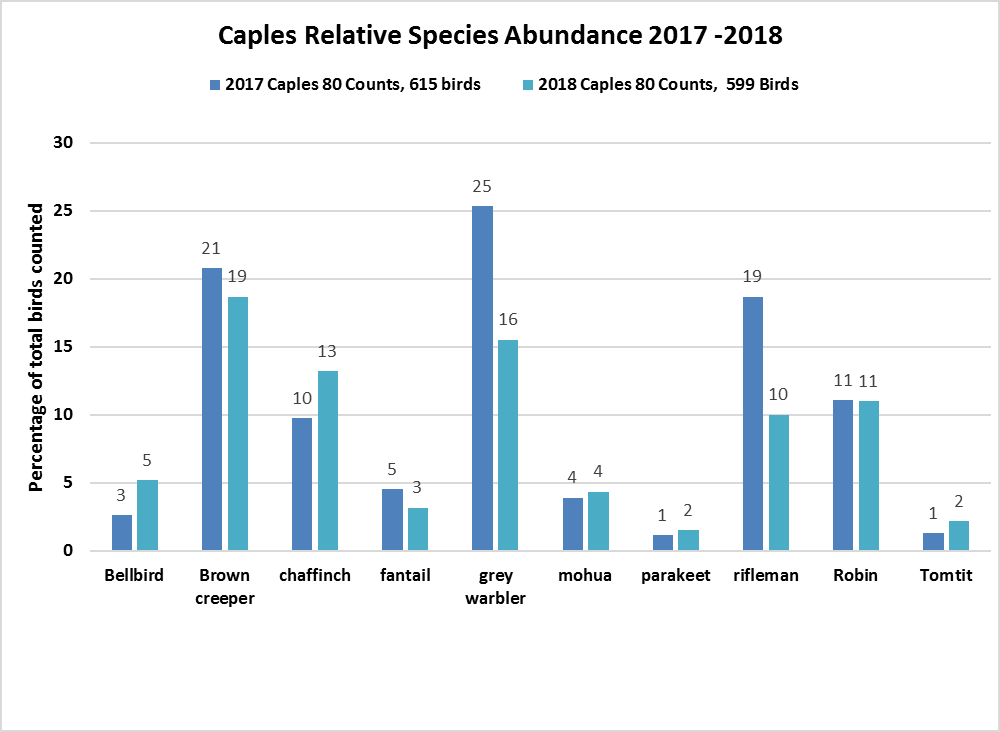 Dart Caples Routeburn 5 Minute Bird Counts 2018
Introduction
Dart Caples Routeburn 5 Minute Bird Counts 2018
Introduction
Counts are carried out in October each year, there are 26 five min bird count stations in
the Dart, 30 in the Routeburn and 20 in the Caples
Standard methodology is used
These counts provide an index or a measure of abundance as not all birds present will be
detected.
Act
The Five-minute bird counts are conducted in conjunction with Mohua transect surveys to
enable efficiencies.
Results
Bird numbers counted at the stations were down approx. 20% on 2017
Total bird abundance has dropped from 2016 (12 birds per 5mbc) and 2017 (9 birds per
5mbc), to 8per 5mbc in 2018; a factor of the natural fluctuations linked to Beech cycles,
predation, food availability and climate.
Relative Species Abundance Of note is the drop back of the Chaffinch population which normally sits above our
Information
native species in the mean counts and abundance, in some cases Grey Warbler, Rifleman
and Brown Creeper percentages have crept above Chaffinch over this 2-year period, a
contributing factor is the 2 successive 1080 operations dropping the Chaffinch back,
(Chaffinch are known to eat bait fragments)
The graphs demonstrate the percentages of species make up from the total counted.
Note:
not all species are shown on graphs, rather ones we are more interested in.
Official
the
under
Released

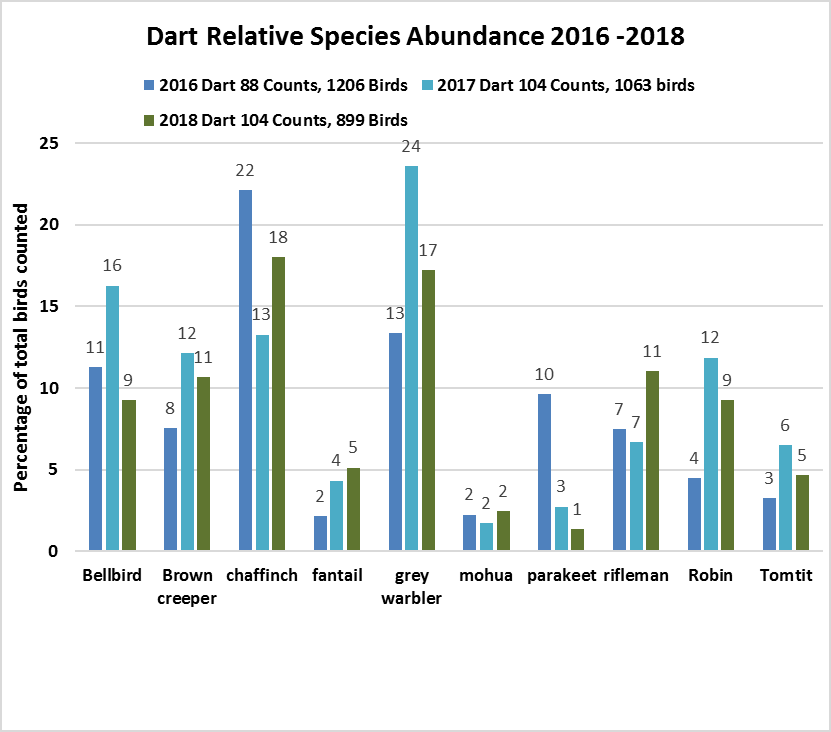
Act
Information
Official
the
under
Released
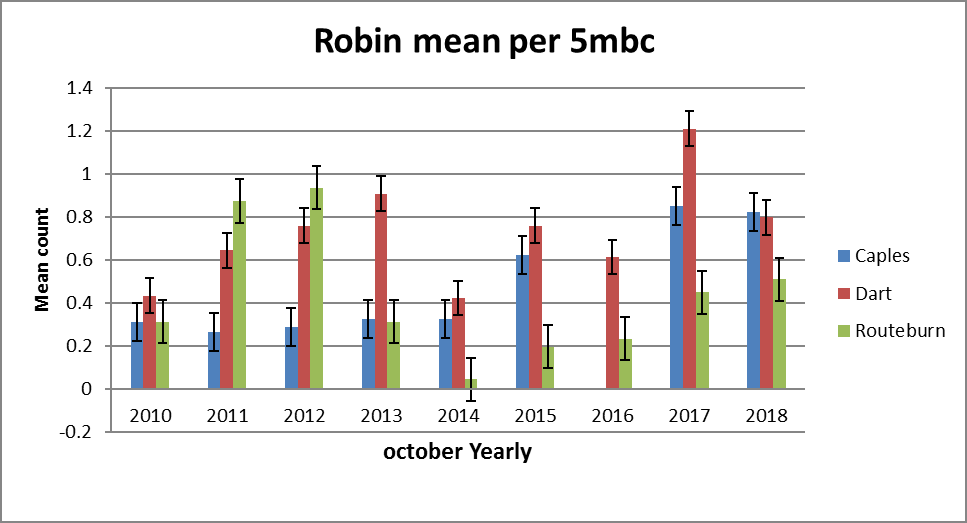 Mean counts
Mean counts
The mean is the measure used as opposed to totals of each species as the number of 5mbc
stations used per year can change.
Generally, species are constant or increasing since the last full mast in 2011, species more
susceptible to rodent predation show larger variances.
A full mast is again predicted for 2019.
Parakeet abundance sways wildly with food source, they respond to Beech masts with
Act
large increases in abundance, although this is short lived.
Robins have responded particularly well to 1080 operations carried out in the Dart, Caples
and Routeburn. Large increases post 1080 operations of 100% to 200 have been realized
in 2007, 2010, 2015 and 2017 (the year following control with 1080).
Information
Official
the
under
Released
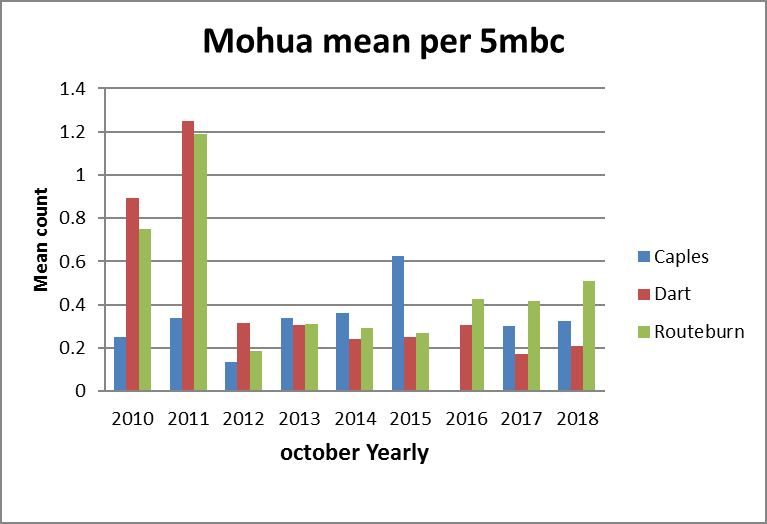

Act
Information
Official
the
under
Released
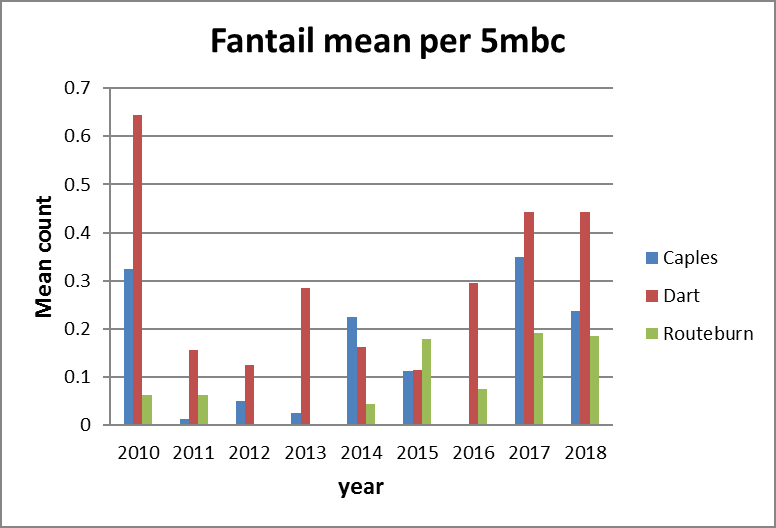
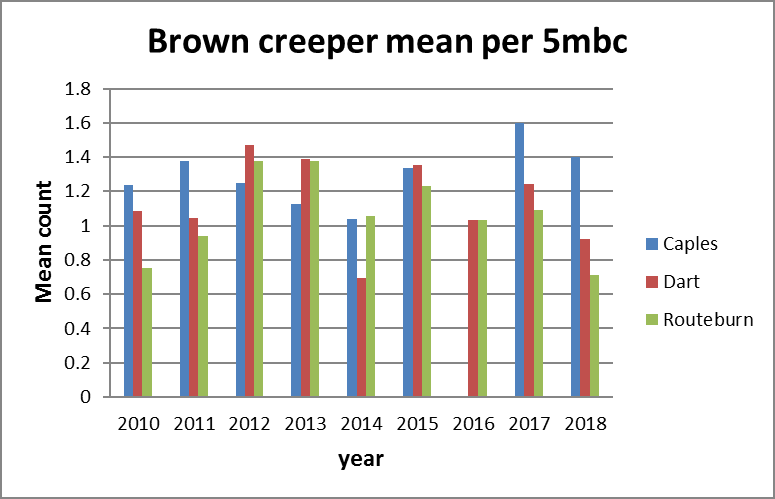
Act
Information
Official
the
under
Released
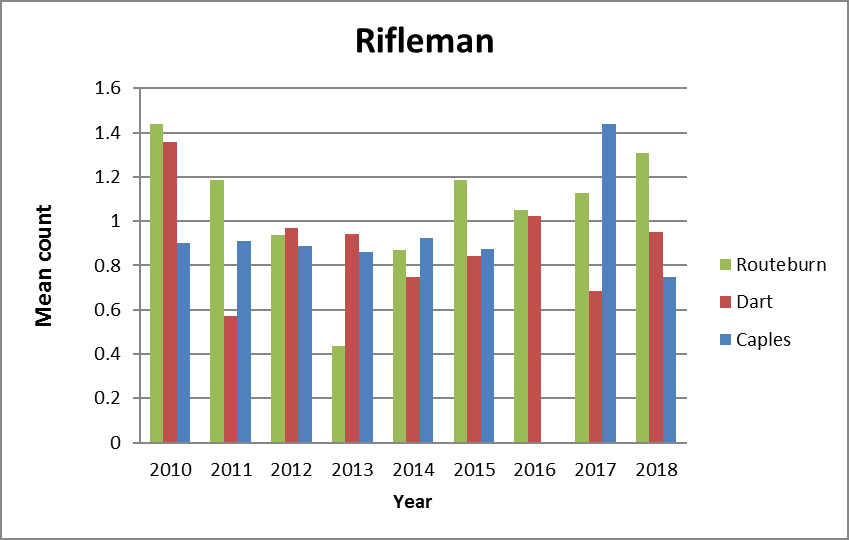
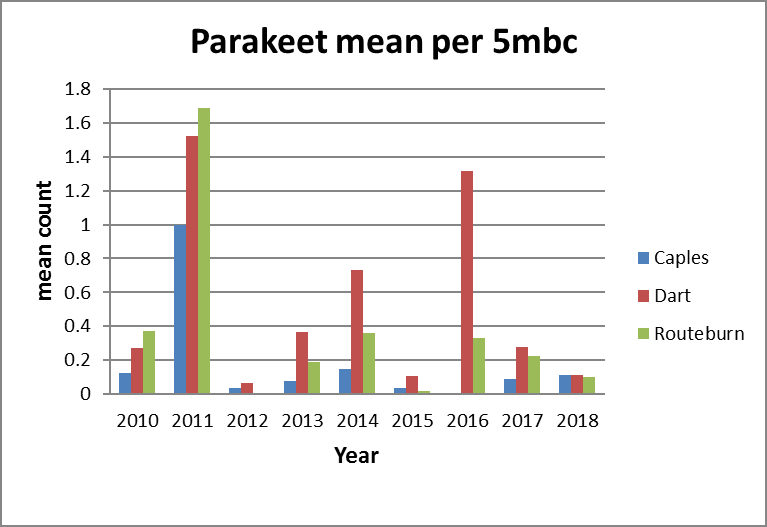
under the Official Information Act
Released
Excerpt from Assessment of Environmental Effects for Rat
and Possum Control in the Dart-Routeburn-Caples Treatment
Area, July 2016 –June 2021
Section 5.3 Effects of proposed operation on non-target native species
Effect on
Studies carried out on native and non-native species suggests
native birds
1080 is likely to be toxic to most native animals. There is wide
variation in sensitivity between taxonomic groups. Mammals are
more sensitive than birds and invertebrates on a weight for
weight basis. The small size of many native species relative to the
target pests means that toxic baits used for pest control are
capable of causing harm to almost any animal that eats the bait.
Therefore, the level of exposure to the bait becomes important in
determining the effects on non-target native spec es in the field.
There are records of a range of native bird species found dead after
aerial poisoning operations and many of these individuals have
contained residues of 1080. However, when records are
discounted: from operations which did not meet current bait
quality standards (e.g. using unscreened, un-dyed carrot bait with
berry fruit lures) or from those animals which did not have
detectable 1080 residues, the Department of Conservation,
Vertebrate Pesticide Residue Database 1994-2008 contains only 31
individuals represent ng 8 native species across all bait types used
in aerial poisoning. No conclusions about population effects can be
drawn from this information but it is useful to focus further studies.
Eleven species of native birds have been intensively monitored,
and several other bird species monitored using less precise
techniques. None of these studies have identified a population
level mortality that threatens the viability of the species. All 87
kiwi, 60 kāka, 19 blue ducks and 15 kereru monitored through
aeria poisoning operations using radio transmitters, survived
(Broome et.al, 2009).
under the Official Information Act
Limited monitoring of NZ falcon, kākāriki, short tailed bats and
Australasian harriers does not indicate detectable mortality due
to aerial poisoning.
Risks to threatened bird species present in the treatment areas
(see section 3.3) are discussed below. However, it is again
important to note that most of these are not ‘wetland’ species that
are dependent on, or associated with, wetlands above 800m in
altitude. Accordingly, the aerial discharge of 1080 to regionally
significant wetlands above 800m is considered to pose little or no
risk to the majority of these species.
Released A total of 68
weka (
Gallirallus australis) has been exposed to this
method and bait type over 4 operations and 1 has died from
poisoning.
A total of 23 radio tagged
morepork (
Ninox novaeseelandiae)
has
been exposed to
this method and bait type over 5 operations and
none have died from poisoning (Greene et al. 2013). Call count
monitoring at Waipoua did not indicate significant 1080 related
mortality (Pierce & Montgomery, 1992 cited in Broome,
Fairweather & Fisher, 2009).
A total of 59
fernbirds (
Bowdleria punctata)
has been exposed to
this method and bait type over 3 operations and 7 have
disappeared after poisoning.
A total of 64 colour banded
robins (Petroica australis) has been
exposed to
this method and bait type over 2 operations and 10 have
disappeared after poisoning.
A total of 29 colour banded
tomtit (
Petroica macrocephala) has
been exposed to
this method and bait type over two operations and
1 has disappeared after poisoning. A monitoring study in
Tongariro using distance sampling found no significant difference
in the mortality of tomtit between the treatment and non-
treatment sites (Westbrooke, Etheridge & Powlesland, 2003 cited
in Broome, Fairweather & Fisher 2009). This study was extended
with an additional site treated with cereal pellets at 3 kg/ha at Mt
Pureora in 2003. Results from all three sites led the authors to
conclude that aerial poisoning operations using cereal pellets at
low sowing rates causes “… ittle, if any…” short term impacts on
tomtit populations (Westbrooke & Powlesland (in preparation)
cited in Broome, Fairweather & Fisher 2009).
Blue duck (whio) (
Hymenolaimus malacorhynchos)
are
unlikely to
eat cereal pellet baits and their aquatic invertebrate
prey are unlikely to be contaminated by 1080. However, studies
have been done to determine their survival following aerial 1080
operations. There was no reduction in visual counts of blue duck in
the Otira valley after application of 0.15% 1080 Pellets at 6 kg/ha
in 1989 (Spurr & Powlesland, 1997 cited in Broome, Fairweather &
F sher 2009). Additionally, all 19 radio-tagged blue ducks in
Waihaha survived for at least four weeks following aerial
application of carrot bait (0.08%) at 15 kg/ha (Greene, 1998 cited
in Broome, Fairweather & Fisher 2009).
under the Official Information Act
A total of 60 radio tagged
kāka (Nestor meridionalis) have been
exposed to
this method and bait type over 4 operations and none
have died from poisoning. Additionally, 38 radio tagged birds have
been exposed to
0.08% carrot baits
over 2 operations and none
have died from poisoning (Greene et al. 1998; Powlesland et al.
2003).
Kereru (NZ pigeon/kūkupa) (
Hemiphaga novaeseelandiae)
have not been monitored individually when exposed to
this method
and bait type. However, none of six birds ate non-toxic cereal
Released pellets offered in a trial on Kapiti island (Spurr & Powlesland,
1997). Monitoring of kereru during 5 aerial 1080 operations using
cereal pellets did not detect population changes using the five
minute count method (Spurr & Powlesland 1997). Additionally, all
15 radio tagged birds exposed to an aerial 1080 operation using
carrot bait survived (Powlesland et al. 2003).
Kārearea (NZ falcon) (
Falco novaeseelandiae) have not been
monitored individually when exposed to
this method and bait type.
However falcon territories have remained occupied, presumably by
the resident birds, during four aerial 1080 operations using cereal
pellets (Pureora 1984, Mapara 1990-92) and one using carrot bait
(Waihaha 1994) (Spurr & Powlesland, 1997). The total number of
Act
falcon involved in this monitoring is about 13, although the Mapara
birds (3 pair) were exposed in three consecutive years (Calder &
Deuss, 1985: Bradfield, 1993 cited in Broome, Fairweather &
Fisher, 2009); Greene et al. 1998).
Kākāriki (parakeet) (
Cyanoramphus spp.) nests have been
monitored during two aerial (cereal) 1080 operations. Fifteen
nests were monitored during the October 2007 Hurunui Valley
operation and a further seven nests were monitored during a 1080
operation in the Dart Valley. Dead chicks in a failed nest in the
Hurunui Valley operation contained 1080 residues and the female
was not seen after the nest failed. All the monitored nests in the
Information
Dart Valley operation were successful, however two unmonitored
kākāriki were found dead with 1080 residues in their tissues. The
combined estimate of mortality of nesting parakeets from these
operations was 2.27% (0.1-12 % 95% CI) (Rhodes, Elliot & Kemp,
2008 cited in Broome, Fairweather & Fisher, 2009). The authors
concluded that while some kākāriki were killed during the 1080
operations, given the rate of nest predation observed in areas
where no predator control was carried out, the net benefit from the
Official
1080 operations was positive. No detectable impact could be
determined through five minute bird count monitoring after four
aerial 1080 operations using carrot or cereal pellet baits (Spurr &
Powlesland et al. 1997). Additionally following an intensively
the
monitored aerial 1080 operation in Waihaha in 1994 using carrot
bait, (Greene et al. 1998) observed “…kākāriki remained common
within the study area...”.
Kāhu (Australasian harrier) (
Circus approximans) have not
been monitored individually when exposed to
this method and bait
type. However no detectable impact could be determined through
under
five minute bird count monitoring before and after an aerial 1080
operation using cereal pellets on Rangitoto Island and “the small
resident population was still seen…throughout the year following
the poisoning” (Miller & Anderson, 1992). Additionally, (Pierce &
Maloney, 1989 cited in Broome, Fairweather & Fisher, 2009) found
no evidence of dead harriers after aerial 1080 poisoning of rabbits
in the McKenzie basin.
A total of 145 radio tagged
kea (
Nestor notabilis) have been
exposed to
this method and bait type over 10 operations and 20
have died from poisoning in 3 of these operations. Additionally,
Released 2 radio tagged birds have been exposed to
0.08% carrot baits
over 1 operation and none have died from poisoning (Kemp & van
Klink, 2008 cited in Broome, Fairweather & Fisher 2009).
Research indicates that stoats are the most important predator of
kea and the impacts are most severe following mast events, which
is when stoats occur in high numbers. Effective stoat control
improves kea breeding success (productivity) and survival
whereas unchecked stoat irruptions following mast years can
drive kea productivity to near zero.
Mortality of individual birds as a result of using aerial 1080 (in
those few operations where this has occurred) is therefore offset
Act
by increased productivity in the remainder of the population due
to the reduction in stoat predation (resulting from secondary
poisoning – see section 5.7).
Options to manage risk and/or levels of exposure:
Adopting accepted operational practices reduces the risk for birds.
Techniques developed in recent years are important components of
the operation. For 1080, dull-green dyed bait has been shown to be
the least attractive colour to birds. Cinnamon−lured baits instead
of fruit lures help to repel most birds. Ensuring bait meets all
quality specifications is considered the best way to avoid adversely
affecting birds.
Information
During 2014, the DOC Pesticide Advisory Group reviewed the
research results to date to recommend new compulsory
performance standards. The following new standards have been
approved by DOC's general management, to be applied to all new
permissions for aerial 1080 operations in areas where kea are
present.
Official
The following compulsory performance standards will apply:
• Only use cinnamon lured RS5 pellets
• Use an average of 2kg/ha of prefeed bait for 12g baits (or
1kg/ha for 6g baits)
the
• Use an average of 2kg/ha of toxic bait for 12g baits (or
1kg/ha for 6g baits)
One previous standard has been removed, which prevented baits
being sown in open areas above the treeline. Instead, the alpine
boundary will be evaluated as part of the DOC permission process,
to weigh up the potential risk of visible baits in open areas against
under
the benefit of alpine predator control to protect species like rock
wren.
This operation will adhere to these standards to ensure that the risk
to kea is minimized to the extent that current research indicates is
required.
Effect on bats
Lesser short-tailed bats (
Mystacina tuberculata) feed on arthropod
taxa that are known to consume 1080 baits. Thus, the bats may be
Released vulnerable to secondary poisoning after control operations using
aerially broadcast 1080 baits and residues in these prey can in
theory be enough to kill a bat. Lloyd (1994) offered non-toxic cereal
pellets containing a fluorescent marker to captive bats and hand
broadcast baits throughout an area known to be inhabited by bats
and concluded
“…short-tailed bats are unlikely to eat carrot or
grain-based baits…”.
In a study in Rangataua Forest where 0.15% 1080 pellets were
aerially broadcast (3 – 5 kg/ha) over
“…almost the entire winter
range…” of the study animals, a total of 269 short-tailed bats were
caught at their roost following poisoning and held for 48 hours to
determine mortality or signs of poisoning. All animals survived
and showed no signs of 1080 poisoning (Lloyd & McQueen 2002).
This result compares favourably for the assessment of risk for
insectivores surmised by an earlier study (Lloyd & McQueen
2000).
As noted in section 3.3 of this AEE, at altitudes above 800m bats
would be more commonly using areas that are forested rather than
tussock grasslands where wetlands may be present. Accordingly,
bats are not likely to be adversely affected by the discharge of 1080
to regionally significant wetlands above 800m.
Effect on
The effect of aerial 1080 operation on common invertebrates
Invertebrates
within regionally significant wetlands will be minor.
Invertebrate populations have been monitored in several aerial
1080 poisoning operations and none have shown significant
population effects on any species studied, nor is there evidence to
suggest poisoned inverteb ates are a significant factor in
secondary poisoning of other animals. Long-term monitoring of
native land snails indicates substantial benefits to threatened
populations in sites treated with aerial poisoning due to reduced
predator populations.
An extensive study of forest invertebrates on 1080 baits (Sherley
et al. 1999) found that at any time only a small proportion of baits
had invertebrates on them, and the few individuals per bait
represented a small section of the fauna present in the litter. The
number of invertebrates recorded on baits in treatment grids
declined when 0.15% 1080 pellets were laid at 18 kg/ha, but
started to return to original levels (relative to control grids)
within 6 days of removal of the toxic baits. This sowing rate is
under the Official Information Act
approximately nine times that proposed to be used in this
operational area. The reduction in invertebrate numbers did not
extend further than 20cm around any bait.
Another study (Spurr & Berben, 2004 cited in Broome,
Fairweather & Fisher, 2009) hand laid 0.15% 1080 cereal pellets at
5 kg/ha to simulate aerial poisoning in Tararua Forest Park in 1999
and monitored the occupancy of artificial refuges by tree weta
(
Hemideina crassidens) and cave weta (
Isoplectron sp.). No
significant impact of bait application was found for these species
nor was there any effect observed on numbers of slugs, spiders and
Released cockroaches, which also commonly used the same refuges.
No impact was detected on populations of weta in Waipoua Forest
and all cockroaches, centipedes, millipedes, kauri snails and all but
one beetle survived in enclosures with 0.08% 1080 pellets (Pierce
& Montgomery et al. 1992).
Spurr (1994b cited in Broome, Fairweather & Fisher, 2009) found
no impacts on populations of amphipods, ants, beetles,
collembolans, millipedes, mites, slugs, snails, spiders and cave
weta at Puketi Forest or Titirangi Scenic Reserve where 0.08%
1080 pellets were aerially applied at 5 kg/ha.
Act
In Mapara where 0.08% 1080 pellets were aerially applied in three
consecutive years (1990-92), a comparison of invertebrate fauna
showed a greater number of predatory insects in the treatment site,
characteristic of a healthy forest, and more fungal eating insects in
the non-treatment site, characteristic of unhealthy forest
(Bradfield, 1993 cited in Broome, Fairweather & Fisher, 2009).
Effect on
Reptiles are highly tolerant of 1080 (Spurr 1993). Lizards have not
reptiles
been monitored in any 1080 poisoning operations prior to 1994;
however, none have been reported killed by 1080. Captive
McCann’s skinks (
Oligosoma maccanni) ate non-toxic cereal
Information
pellets (RS5 and Agtech), especially when the baits were wet, but
the level of consumption (0.01-0.02g) was probably insufficient for
the animals to have received a lethal dose had the baits been toxic
(Freeman, 1997).
Effect on fish
Significant adverse effects on fish and other aquatic fauna do not
and other
occur based on the following data:
Official
aquatic fauna
• Water contamination is rarely found and extremely low level
when it has occurred,
• In a study conducted by NIWA (Suren & Lambert, 2006) no
mortality of fish due to 1080 leaching from baits was observed
the
• Eels have survived experimental feeding of cereal pellets and
possum tissue containing 1080 (Suren & Lambert, 2004)
It therefore seems unlikely that fish or benthic macro-invertebrates
within the treatment area will be adversely affected. Fish are in any
case unlikely to occur in wetlands above 800m (see section 3.3 of
this AEE).
under
Section 5.3.1 Proposed consent conditions to avoid, remedy or mitigate adverse
effects on non-target native species
Consent
Ensuring 1080 bait meets all quality specifications is considered
conditions for
the best way to avoid adversely affecting birds and other native
non-target
species
native species
Released
1. 1080 baits will be lured with cinnamon
2. 1080 baits will be dyed green to deter birds.
3. 1080 baits will be sown at an effective average sowing rate not
greater than 2 kg/ha.
4. RS5 baits will be used.
In addition, the following conditions are proposed:
5. The aircraft will have global positioning system (‘GPS’)
guidance equipment to map and control the bait spread. This
Act
equipment will:
• allow highly accurate bait placement on all parts of the
operational area;
• display exclusion zone boundaries; and
• monitor application rates to ensure that they are within the
correct range
6. The pilot of any aircraft used to discharge 1080 must hold a
current GrowsafeTM Agrichemical Pilots Rating Certificate or
equivalent alternative certification.
Information
Official
the
under
Released

Act
Information
Official
the
under
Released










